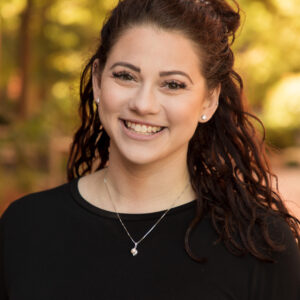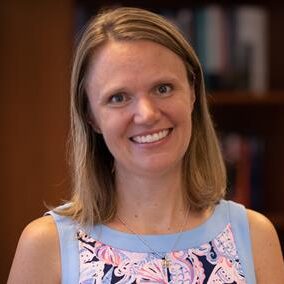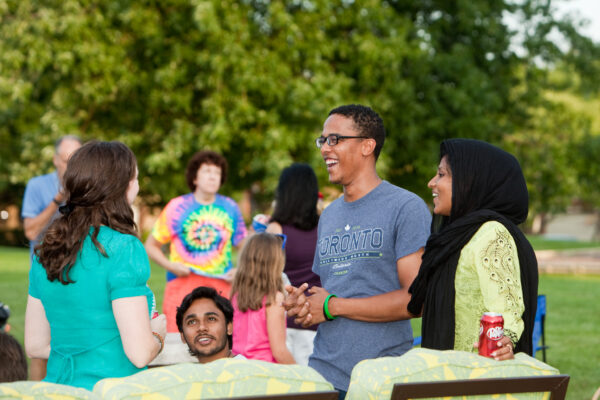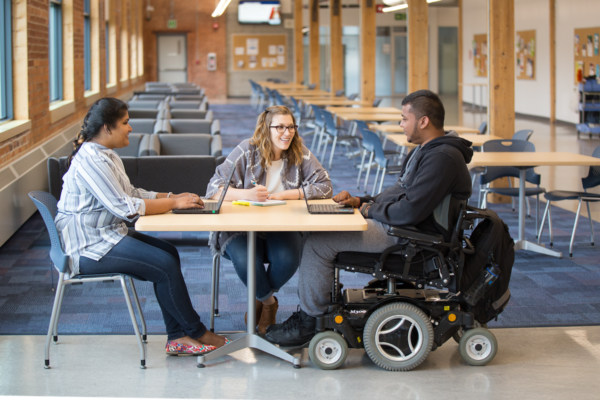Colleges and universities are at the forefront of a cultural shift, as the experiences of COVID-19 and the perspectives of Gen Z students catalyze a more open dialogue about the social and contextual implications of disability. However, disability encompasses a wide range of conditions and manifests differently in each individual.
Students with disabilities face extra steps in higher education, carrying the responsibility of navigating what they need both inside and outside the classroom. Many students also navigate other marginalizations in addition to their disability status. Students with non-apparent disabilities walk a fine line of being afforded the privileges that go with looking “normal” and having to navigate a world that was not designed for how their bodies function.
As a woman with non-apparent disabilities, Kara has the privilege of choosing when and how to disclose her chronic illnesses. We both also benefit from the systemic advantages afforded to White people. But college campuses are home to a diverse population with a wide range of visible and invisible disabilities, including mental health conditions, physical impairments, and chronic illnesses. It’s also essential to be mindful of how disability intersects with other identities, such as race, gender, and socioeconomic status. Looking toward the start of the fall semester, this post will explore these complexities and offer recommendations for creating a more inclusive campus environment.
Disability in higher education
According to the National Center for Education Statistics, 21 percent of undergraduates and 11 percent of post-baccalaureate students indicated that they have a disability. In the context of higher education, people often associate “disability” with accommodations, like longer test-taking times or accessible restrooms. Yet disability is not a monolithic term or experience—it exists far beyond the walls of the classroom. Disability affects all campus spaces and places, from residence halls to dining facilities, and all social contexts. In addition to how it can impact physical and social spaces, disability can affect every aspect of a student’s life. Whether it be the choice to disclose a disability or where to park for class, the experience of disability is dynamic and can be unpredictable.
Disability as a construct
Understanding that disability is socially constructed is the key to thinking about how to create a welcoming campus for students, staff, and faculty who navigate disability. Disability is the only identity label with deficit orientation in it—“dis” means not or opposite. What is important to note is that as society evolves, so do the ways that higher education defines disability. Only recently have mental health accommodations become more common and necessary for many students who endured education in the time of COVID-19.
Race and disability
Disability is often thought of as the “othered other.” More than 50 percent of students with disabilities identify as non-white. Students of color are traversing an education system that is not designed with their success in mind, and for students of color with disabilities, it is nearly impossible to separate out their intersecting identities. This means students of color with disabilities have an extra layer of decisions and barriers to face on top of the already complex facets of disability—the question of even disclosing disability holds far more risk for them.
Disability and disclosure
Many students with documented disabilities choose to not disclose disability status due to the social, emotional, and academic stigma associated with it. Known as disability stigma, this fear of discrimination, stereotypes, and negative perceptions can weigh heavily on students. The stigma can extend beyond the classroom, as peers may perpetuate stereotypes or lack understanding. Additionally, while there are legal protections (such as the Individuals with Disabilities Education Act for K-12, and the Americans with Disabilities Act and Section 504 of the Rehabilitation Act of 1973 for all ages and settings) that are meant to support disability, those depend on disability being viewed as valid.
Below are some recommendations and advice for campus administrators:
Policies provide a baseline, but they alone are not enough. Have systems in place for feedback.
Hold town halls or coffee chats for students of color with disabilities. This is a great way to help facilitate affinity spaces. Ask students about their experiences and just listen. In the solution-driven world of academia, it is easy to want to respond immediately by outlining the structures that are already in place. Instead, take notes on students’ experiences and reflect on what needs to change. Acknowledge that students face unique barriers, and, above all, make sure you know that the students themselves are not problems or a burden. You may also consider having an anonymous form option where students can submit experiences that they have without fear of retaliation or disclosure.
Try to know what is happening on the ground—disability service centers are often overworked, understaffed, and bear the burden of being the primary advocates for students on campus. Ask about what happens if students’ needs are not being met through these centers—for example, what accountability is in place for faculty who deny accommodations or make ableist remarks?
Know that there will always be students who choose to not use disability centers, but that does not mean they do not deserve empathy or flexibility. This begins with clear messaging from administrators that disability is important.
Institutions play a vital role in how they create disability culture on their campus. In any anti-discrimination messaging on campus, name disability explicitly. You can go one step further by not only acknowledging disability but also recognizing that it is not a monolithic experience and comes with its own set of challenges, especially for students who are multiply marginalized. Doing this may not feel like a big action, but so often disability is left out of conversations. By explicitly mentioning these things, you are showing that you understand the complexities of disability in a way that is not just performative or delegating to already existing structures. Include this messaging in campus-wide emails, cultural centers on campus, and common spaces. Doing so is a great way to show that disability is socially constructed and extends beyond academic settings.
One simple acknowledgment can come through language. Some people prefer the approach of a person-first identity, or saying that they are people with a disability. A more common example of this is saying “student with autism.” In contrast, some people prefer identity-first language, i.e., “autistic student.” Those who prefer person-first tend to cite its humanization: they are a person first, before anything else. Those who prefer identity-first often feel that disability is integral to their identity or want to debunk the idea that disability is a bad thing. Best practice is to follow the language an individual uses.
We know from Kara’s research and from speaking to students of different backgrounds that there are a slew of reasons students choose to not pursue accommodations, be it that there is not awareness about federal policies that protect them in the real world, bad experiences with staff or faculty at school, cultural and social stigma, or not knowing that accommodations are even an option.
Task student affairs professionals with focusing on disability to create a culture that values disabled joy.
As we mentioned in the last recommendation, messaging from campus leaders is key. To address stigma around disability, especially in nonacademic spaces on campus, student affairs professionals may help facilitate affinity spaces, run brown bag lunches for students to learn about disabilities, highlight famous individuals who navigated multiple marginalizations, and/or promote student storytelling (for those who are comfortable sharing their stories). Perhaps there can be an interactive poster or mural of “what does disability look like and how does it affect me on campus” outside the classroom where students can share responses throughout the semester.
Student affairs professionals can also plan events using the key principles of Universal Design for Learning (UDL). While UDL is a commonly accepted framework for learning, its principles can still apply to activities beyond the classroom. Perhaps staff offer multiple ways to approach an activity at an event or have free snacks and water ready for students who may need that for their health conditions. Take the burden off of the students and incorporate these inclusive options as the baseline. Doing so creates spaces for faculty, staff, and students to learn about the depth of disability culture.
For further reading:
The APA provides a brief overview on models of disability in society.
The National Center for Disability and Journalism provides a clear, easy-to-follow guide.
The Association on Higher Education and Disability (AHEAD) provides great research, events, and resources for higher education and disability. They are a membership organization with multiple knowledge practice communities available for those who join.
The Association of University Centers on Disabilities (AUCD) offers ongoing updates and resources for disability service professionals in the higher education space. They specifically have different member networks for working with different populations, so be sure to poke around and find what best applies to you.
The Disability Rights, Education, Activism, and Mentoring Group (DREAM) is a student-run organization for college students with disabilities. Run by the National Center for College Students With Disabilities (NCCSD), it offers a network of peers for students and the ability to have a chapter or affiliate on your campus.
If you have any questions or comments about this blog post, please contact us.




